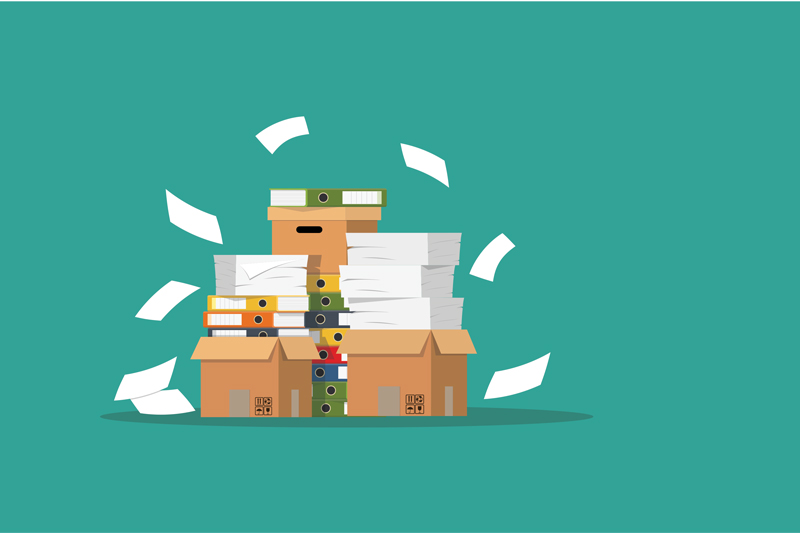Is April a breath of fresh air for you? Do you look forward to temperatures rising and chirping birds resuming their seasonal singing? Are you inspired to get moving again and do a bit of spring cleaning? Use this month to organize your financial records! As a recovering “statement squirrel,” I can attest to the peace of mind that an organized approach to financial records provides.
For years, whenever I opened a piece of mail, I’d feel tightness in my chest and a knot in my stomach as I wondered, “How important is this?” “Do I need to keep this?” “How long do I need to keep this?” I managed this anxiety by keeping as many papers for as long as possible hidden as discreetly as possible. In my first apartment, I shoved important documents in a special storage box in the bottom of my bedroom closet. Then after I married another statement squirrel, my husband and I bought a couple of filing cabinets and a fire-proof safe to store our respective and combined piles. Over time, he and I began using electronic storage to scan and retain everything, though we were inconsistent doing it.
No matter what I did, inevitably every month I’d discover (at least) one paper grocery bag of “important papers I need to go through when I have a few minutes,” and I’d worry that I was missing something. I learned from trusted friends who were “tornado trashers,” that they worried, too. In their compulsion to get rid of documents, they wondered if they were managing their records “right”. Today were they keeping the items that mattered? Tomorrow would they regret the documents that they shred?
If any of this resonates with you, here are three steps you can follow to increase your control managing your financial records and decrease your stress:
1. Understand the purpose of each document
Different financial records serve different purposes. For instance:
- Budget monitoring and management: pay stubs, bills, and bank account statements provide clarity on day-to-day spending. You can use these to monitor and adjust your behaviors, live within your means, and pay off debt.
- Financial and tax planning: investment statements, insurance policies, tax returns and supporting information, ongoing debt obligations (mortgages, student loans, etc.), and financial plans prepared by your Certified Financial PlannerTM. You can use these to understand what you own, what you owe, and what’s currently available to you to pay for your financial goals over time.
- Estate planning: trusts, wills, health care proxies, and powers of attorney documents. You can use these to stipulate the people and processes to protect and execute your wishes when your life as you know it changes.
The next time you read a financial record, think of which purpose it fits. You may find that in time, and with practice, this approach makes reviewing the paperwork more intuitive and less burdensome.
2. Organize your documents according to how you use them.
As you begin to look at your financial documents according to the different purposes that they fill, it becomes easier to organize them according to how you use them. Consider keeping “short term” items together and “long term” items together, and bucket them into one of three categories according to when you need to access them:
| Category | Description | Example |
|---|---|---|
| Immediate Files | Items from the past year | Budget monitoring and management records |
| Intermediate Files | Items you monitor for multiple years | Financial and tax planning files |
| Forever Files | Items you oversee forever or until they change | Estate planning documents |
3. Follow a simple process that works for you
After organizing your files into categories according to their purpose and when you need to access them, experiment with how best to store them. You know best what brings you peace of mind. Whether it’s keeping your financial records in a canvas bag, electronic media, or some other combination, there is no “right” way for all people to do this. Be patient, be gentle, and allow yourself the freedom to try out and develop in time a sustainable approach that protects your information and works for you.
Some widely-used organization techniques you may find helpful include:
- Even if you use different media to store files (e.g. technology + safe + bins) keep all of the media in one place (e.g. your home office)
- Organize the documents within and across the different media according to a logic that is intuitive and memorable for you
- Apply the same organization logic to all types of your financial records
For more strategies organizing your financial records, including how long to keep different documents and how to protect them, join me on Saturday April 11 at Panera Bread in Westport for “Second Saturdays with Caroline”. For more info, check out Caroline Wetzel CFP on LinkedIn, Facebook, and Instagram, and visit: https://secondsaturdayscarolinewetzelcfp.eventbrite.com/.
Caroline Wetzel is one of Natural Nutmeg’s 2019 and 2018 10Best Winners for Business/Life Coach. Caroline is a Certified Financial PlannerTM (CFP®) and Vice President, Private Wealth Advisor with Procyon Private Wealth Partners, LLC. Procyon Private Wealth Partners, LLC and Procyon Institutional Partners, LLC (collectively “Procyon Partners”) are registered investment advisors with the U.S. Securities and Exchange Commission (“SEC”). This article is provided for informational purposes only and for the intended recipient[s] only. This article may also include opinions and forward-looking statements which may not come to pass. Information is at a point in time and subject to change. Procyon Partners does not provide tax or legal advice.
